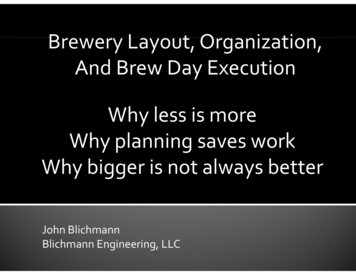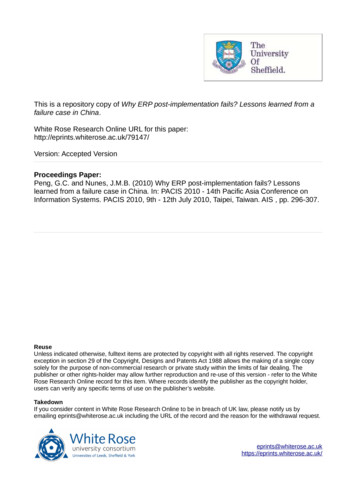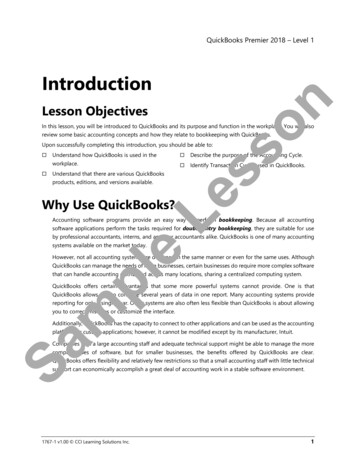
Transcription
Project Accounting BasicsBefore I start narrating on Project Accounting – PA, would like to thank my friend Veeranjaneya whoactually guided me to understand this module and gain confidence on the same and the same would liketo pass it on to my blog followers.With this article I would like to put forward some basic understanding on PA and how it is integratedwith other modules.Why Project Accounting (PA)?Let’s understand PA implementation with an instance, say we own a private business that is responsiblefor hosting a Series of Shows/Movies or a Business which involves huge number of Employees/Labormanagement etc. and if we want to account our Revenue and Expenses in Oracle Application we needPA, In PA each Series of Show/Movies could be a Project defined in the PA Application. Also we need PAto monitor/track status and financial aspects of a project.Oracle Projects Suite consist of the below:1.2.3.4.5.6.Oracle Project FoundationOracle Project CostingOracle Project BillingOracle Project Resource ManagementOracle Project ManagementOracle Project CollaborationOracle Project FoundationOracle Project Foundation provides the common platform shared across other Project Products (costing,billing etc.)Oracle Project CostingOracle Project Costing is an integrated project-based cost collection, management and accountingsolution that allows organizations to effectively manage projects and activities. Costing is the processingof expenditures to calculate their cost to each project and determine the GL accounts to which the costswill be posted.Oracle Project BillingOracle Project Billing can automate revenue generation, simplify client invoicing, improve your cash flowand measure the performance and profitability of Contract Projects. Oracle Project Billing provides youwith the ability to define revenue and invoicing rules for your projects, generate revenue, createinvoices, and integrate with other Oracle Applications to process revenue and invoices. Oracle ProjectBilling also integrates with Oracle Receivables.SURYAKANTH GUNTI1
Project Accounting BasicsOracle Project Resource ManagementPRM is an integrated project staffing application to help you to manage project resource needs,profitability and organization utilization by locating and deploying qualified resources to projects acrossyour enterprise.Oracle Project ManagementProject Management provides project managers the visibility and control they need to deliver theirprojects successfullyBasic PA conceptsProjectsA project is a primary unit of work that you can break down into one or more tasks. When you set up aproject, you must set up the work breakdown structure (WBS), and enter project and task information.Project TemplatesA standard project template when created, can be used in creating other projectsProject TypesAll Projects are assigned a Project Type. The project type determines how Oracle Projects processescosts (expenditure items) for a project and provides defaults and controls for project entry andprocessing. Contains the default revenue distribution rule, bill rate schedules etc. It’s the key to AutoAccounting.You must associate each project type with a project type class ‘Indirect’ to collect and track expenditure.‘Capital’ to collect and track costs and capitalize‘Contract’ to collect and track costs and billing for services performed for and reimbursed by aclient.Let’s now begin with creating a Project:Navigation: Forms Menu ProjectsSURYAKANTH GUNTI2
Project Accounting BasicsThe primary table that stores Project information is PA PROJECTS ALL. Both Project and ProjectTemplate information is stored in this table. The “Template Flag” is an indicator of the nature of therecord in this table.Field ‘SEGMENT1’ denotes the Project Number and Project ID is field common in almost all the PA andother Tables.Your project, which consists of one or more tasks, can be as simple or detailed as you want it to be.You can define an unlimited hierarchy of tasks, called a work breakdown structure (WBS), to organizeand monitor project activities.PA TASKS stores user-defined subdivisions of project work. All the details relating to the task could beretrieved from this table. Tasks can be broken down into multiple levels of subtasks. The depth andwidth of the Work Breakdown Structure (WBS) are unlimited.Project Key Members:Employees who can enter and maintain project data, view cost details charged to the project. Eachproject can have only one project manager at a timePA PROJECT PLAYERS stores the information of key members and could be linked with HRMSPER ALL PEOPLE F using the field ‘person id’.Project Customers:All the Contract Projects should have a customer defined in the Project Customer Screen. Customers aredefined in AR and is selected in PAPA PROJECT CUSTOMERS stores customer related information and this could be linked withRA CUSTOMERS in AR using the field ‘customer id’Project ClassificationsUser-definable project classification categories and codes. For analysis and reportingSURYAKANTH GUNTI3
Project Accounting BasicsProject AgreementsAgreement screen is used to enter the contract value agreed upon with the customer, payment termsetc. Invoice and Revenue hard limits at the funding screen makes sure that you won’t Invoice/Recognizerevenue more than the funding. Total agreement amount is allocated to various tasks/projects at thefunding screen. Funding could be done at the Project Level or at the task level.Defining Project AgreementNavigation: Billing AgreementsTable: PA AGREEMENTS ALLFunding ScreenYou must fund a project before the project can accrue revenue and be billed. Funding is the step thatallocates an amount associated with a customer agreement to a specific project.Table : PA PROJECT FUNDINGSSURYAKANTH GUNTI4
Project Accounting BasicsProject ExpenditureYou charge expenditures to a project to record the actual work performed or cost incurred. Actualexpenditure could be timecards, expense reports, usage logs and supplier invoices. An expenditure is agroup of expenditure items, or transactions, incurred by an employee or an organization for anexpenditure period.Expenditure Concepts:Expenditure Type ClassAn expenditure type class tells Oracle Projects how to process an expenditure item. Oracle Projectspredefines all expenditure type classes.Examples of exp. type classes are Expense Reports, Miscellaneous Transaction, Usage Costs, SupplierInvoice etc.Expenditure CategoryAn expenditure category describes the source of your organization’s costs. For example, an expenditurecategory with a name such as Labor refers to the cost of labor. An expenditure category with a namesuch as Supplier refers to the cost incurred on supplier invoices.Expenditure TypeWhen you define an expenditure type, you assign it a unit, an expenditure category, a revenue category,and one or more expenditure type classes.Navigation: Expenditures Pre-approved batches EnterSURYAKANTH GUNTI5
Project Accounting BasicsBased on the Class selected say Miscellaneous Transaction enter the Expenditure Items as belowSubmit and Release the BatchTable PA EXPENDITURES ALL stores groupings of expenditure items incurred by an employee or anorganization for a specific expenditure period. An expenditure also exists for each supplier invoicetransferred to Oracle Projects from Oracle PayablesPA EXPENDITURE BATCHES ALL stores groups of expense reports. The Distribute Expense Reportsprocess creates a batch for all expenditures that it processes in a run. Oracle Projects transfers theentire batch of expense reports to Oracle Payables so that all the expenditures in a batch are transferredtogether. All batches are automatically created as 'RELEASED'A Project could be closed only onceThe entire agreement amount is billed. Revenue is totally recognized to the extent of the contractamount. Expenditures have been incurred fully and budgets are made equal to the actual costs.SURYAKANTH GUNTI6
Project Accounting BasicsCosting Concepts in Oracle PAThe following concepts are associated with costing:1. Raw Cost2. Burden Cost3. Total Burdened CostRaw Cost: Cost directly attributed to work performed. Examples of raw costs are salaries and travelexpensesBurden Cost: This is Overhead or Indirect Cost. Cost of doing business that supports raw cost and cannotbe directly attributed to work performed. Examples of Burden costs are fringe benefits, utility expenses,office space and general and administrative costsTotal Burdened Cost Raw Cost Burden CostOverview of Project Costing processProject Costing includes following steps.1. Enter and approve expenditures through Oracle project costing user interface, or importtransactions. Some of the expenditures are Labor, Non-Labor, Supplier Costs etc.a. OTL Timecard time x rate amountb. Burdening for the project burden costc. Total burdened costSURYAKANTH GUNTI7
Project Accounting Basicsd.e.f.g.PO PO Quantity x PO PriceAP Invoice Line Quantity * Line Price (amount comes from AP)Expense report entire amount entered in i-expense brought forward to Project costingUsage batches – non oracle application – transaction import – hours of utilization ofnon-labour resources * rate amount2. Distribute Costs and derive default accounting. Cost distribution is the act of calculating the costand determining the cost accounting for an expenditure item. Oracle project costing has set ofcost distribution programs that you run, depending upon the type of expenditure. Someimported expenditures are already cost distributed when you import them and do not requirefurther cost distribution processing.3. Generate Cost accounting events. The program PRC: Generate Cost Accounting Events collectscost distribution lines in Oracle project costing and uses Auto accounting to determine thedefault liability accounts for raw and burden costs. It also generates cost accounting events fororacle sub ledger accounting.4. Create Accounting in Oracle sub ledger accounting and transfer the accounting entries to OracleGeneral Ledger.Auto Accounting RulesAuto Accounting: Generation in GL Accounts according to rules using Data Captured in the Project- Project- Expenditure Type- Task- Project TypeRules are created in Auto Accounting to specify the default accounts that the distribution programsgenerate- It is used to specify how to determine the correct account for each cost distribution line.- It creates many different account transactions throughout the business cycleSURYAKANTH GUNTI8
Project Accounting BasicsProject StatusTransfers final Project Accounting Transactions to Oracle General LedgerHere are the set of programs that are executed to integrate PA transaction with Oracle General Ledger––––––PRC: Generate Cost Accounting EventsPRC: Generate Cross Charge Accounting EventsPRC: Generate Revenue Accounting EventsPRC: Sweep Transaction Accounting EventsPRC: Create AccountingPRC: Transfer Journal Entries to GLSURYAKANTH GUNTI9
Project Accounting BasicsIntegration of PA with Other modules like AP/ARAnother illustration of Integration of PA with other modules.Oracle Project AccountingMatch PO to InvoiceAccounts PayablesPurchasingPurchase RequisitionMaterial CostsHuman ResourcesEmployee, Jobsand OrganizationsSupplier InvoicesOracle ProjectsProject Costs&RevenueGeneral LedgerSURYAKANTH GUNTIOracle inventoryCustomer InvoiceOracle Receivables10
Project Accounting BasicsProject Accounting and PO/AP ModuleBased on some setups one can integrate PA and purchasing. Oracle Projects integrates with OraclePurchasing to allow you to report committed costs and obligations against your projects. Using OraclePurchasing, you can enter project-related requisitions and purchase orders, and then report committedcosts of requisitions and purchase orders that are outstanding against your projects in Oracle Projects.Project Purchase RequisitionsIf a Requisition lines containing Project details it can be termed as Project Requisitions. The chargeaccount is generated based on the auto accounting set up in PA in line with the supplier invoice accountgenerator. The PO DISTRIBUTIONS ALL table contain the Project id and Task id details.Project InvoicesIf Invoices contains a project number in the invoice distributions can be classified as a Project Invoices.The invoice distribution account code combination is formed based on the auto accounting set up in PAin line with the supplier invoice account generator. Once these invoices are approved and validated inAP.The program PRC: Interface Supplier Invoices from Payables when this Program is executed in PA,retrieves all eligible posted, project-related supplier invoices from Oracle Payables and interfaces themto Oracle Projects. Another program PRC: Interface Supplier Costs Process is run from PA whichinterfaces the costs to PA.SURYAKANTH GUNTI11
Project Accounting BasicsThe interrelationship between the relevant Payables and Projects tables are as follows:Project Accounting and Receivables ModuleWhen this Program PRC: Interface Invoices to Receivables is executed in PA, collects all eligible draftinvoices in Oracle Projects and interfaces them to the Oracle Receivables interface tables.Integration of Project Accounting with Oracle Fixed AssetsProjects that are defined as “Capital Projects” integrates to Oracle assets. Capital projects enable you tocapture construction-in process (CIP) costs for assets you are creating. Oracle Projects integrates withOracle assets, allowing you to manage Capital Projects in Oracle Projects and update your fixed assetsrecords when assets are ready to be placed in service.-You collect CIP (Construction in Process) and expense cost for each asset you are building.When an Asset is ready to be placed in service, we use Oracle Projects to collect all eligible CIPcost, summarize them and create capital asset line.We can review and make changes to the asset lines before interfacing them to Oracle Assets.SURYAKANTH GUNTI12
Proj
Project Accounting Basics SURYAKANTH GUNTI 1 . - It creates many different account transactions throughout the business cycle . Project Accounting Basics SURYAKANTH GUNTI 9 Project Status Transfers final Project Accounting Transactions to Oracle General Ledger Here are the set of programs that are executed to integrate PA transaction with Oracle General Ledger – PRC: Generate Cost .











